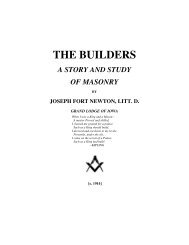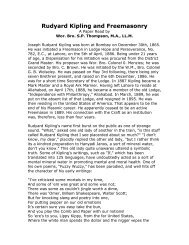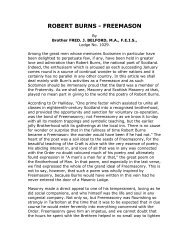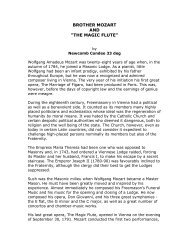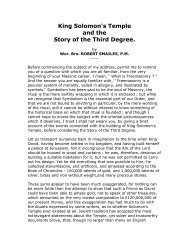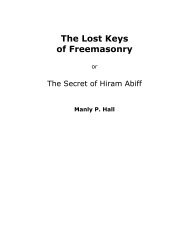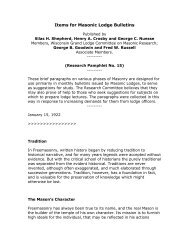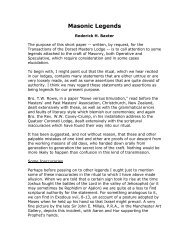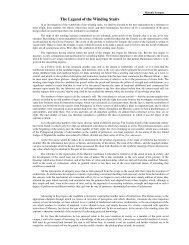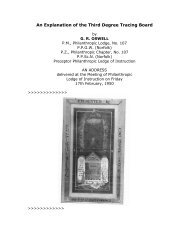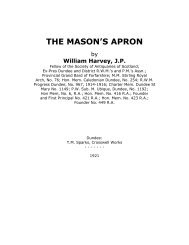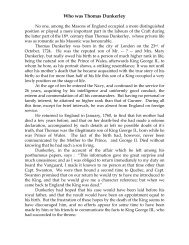Through the Key Hole - RoseCroix.org.au
Through the Key Hole - RoseCroix.org.au
Through the Key Hole - RoseCroix.org.au
Create successful ePaper yourself
Turn your PDF publications into a flip-book with our unique Google optimized e-Paper software.
67<br />
THE COWAN<br />
By Keith Stockley<br />
In a very old book I have detailing “<strong>the</strong> Old Scots” language, <strong>the</strong><br />
word COWAN is shown as a mason who works with dry stone ( in<br />
o<strong>the</strong>r words he does not use mortar).<br />
In an addendum to <strong>the</strong> 1929 edition of THE CONCISE OXFORD<br />
DICTIONARY by Lt. Col. H G Le Mesurier, C.I.E. <strong>the</strong>re is <strong>the</strong> following<br />
entry on page 1464:<br />
COW-AN, n.(Sc). Working but unqualified mason.<br />
In his book “ Book of Ritual”, W Reeves of London, says that <strong>the</strong><br />
word is of French origin and was written as “CHOVAN” with <strong>the</strong><br />
“CH” pronounced as in “CHEMIST” v.i.z. CHOVAN became<br />
COWAN.<br />
The CHOVANS were loyalists during <strong>the</strong> French Revolution and<br />
<strong>the</strong> most determined and inveterate enemies of <strong>the</strong> Charitables:<br />
Robespierre, Bill<strong>au</strong>d-Vareenne, Callot d’Herbois, <strong>the</strong> Duke of Orleans<br />
and <strong>the</strong> rest of <strong>the</strong> revolutionaries.<br />
The CHOVANS were worse than eavesdroppers to <strong>the</strong> masons<br />
who, as history gives ample evidence, were <strong>the</strong> originators of <strong>the</strong><br />
Revolution with <strong>the</strong> infamous Duke of Orleans at <strong>the</strong>ir head.<br />
The CHOVANS were a party connected with several groups of<br />
Royalists of Poiton and Basse Bretagne, distinguished by <strong>the</strong> titles<br />
of Les Charettistes, Les Vandeen, Les Chapeurs, Les Chovans,<br />
Les Brigands, de la Vendee and many o<strong>the</strong>rs, all of whom were<br />
opposed to <strong>the</strong> masons, but <strong>the</strong> most inveterate of <strong>the</strong>se groups<br />
was <strong>the</strong> Chovans.<br />
Perhaps as a result of this all opposers of Masonry <strong>the</strong>reafter were<br />
designated Chovans which was <strong>the</strong> word used to describe antimasons<br />
in many parts of <strong>the</strong> world.<br />
Whatever <strong>the</strong> ‘real’ meaning of <strong>the</strong> word COWAN it is certainly part<br />
of our traditional ritual and in such a way that it refers to someone<br />
who should not be permitted into lodge.<br />
108<br />
THOMAS LYNCH—UNRECORDED MASONIC<br />
SIGNER OF THE DECLARATION.<br />
By Keith Stockley<br />
Now to someone no-one has ever heard of. What is known of course<br />
is that nine Freemasons signed <strong>the</strong> American Declaration of Independence,<br />
including Masonic heavyweights such as Benjamin<br />
Franklin and John Hancock.<br />
Thomas Lynch Jnr was also a signer of this declaration, but he is not<br />
listed as a Freemason. Was he in fact on <strong>the</strong> square? Judge for<br />
yourself.<br />
Admittedly <strong>the</strong>re is no written evidence of his Masonic membership<br />
ei<strong>the</strong>r in America where he was born, or England where he was educated,<br />
but I am grateful to Bro. R.A.N. Petrie who presented <strong>the</strong> results<br />
of his research of certain University Lodges in England in accordance<br />
with which I believe it can be said with some degree of<br />
confidence that Thomas Lynch Jnr was in fact on <strong>the</strong> square and if<br />
indeed this proves to be <strong>the</strong> case <strong>the</strong>n he can be described as an<br />
“Unrecorded Masonic Signer of <strong>the</strong> Declaration.”<br />
He was born in Prince Ge<strong>org</strong>e's Parish, Winyaw, South Carolina on<br />
5 August 1749. His fa<strong>the</strong>r, Thomas Lynch Senior, was a member of<br />
<strong>the</strong> first and second Continental Congresses and a signer of <strong>the</strong> Articles<br />
of Association of 1774. He entered Eton College in England on<br />
9 June 1764 and was entered as a commoner at Caius College,<br />
Cambridge on 18 May 1767.<br />
He was a member of <strong>the</strong> first and second Provincial Congresses, <strong>the</strong><br />
Constitutional Committee for South Carolina, <strong>the</strong> first State general<br />
Assembly and <strong>the</strong> second Continental Congress.<br />
What about his possible Masonic membership?<br />
Ronald E Heaton in his “Masonic Membership of <strong>the</strong> Founding Fa<strong>the</strong>rs”<br />
examines <strong>the</strong> Masonic membership of <strong>the</strong> signers of <strong>the</strong> Articles<br />
of Association, <strong>the</strong> signers of <strong>the</strong> Declaration of Independence,<br />
<strong>the</strong> signers of <strong>the</strong> Articles of Confederation and <strong>the</strong> signers of <strong>the</strong>



